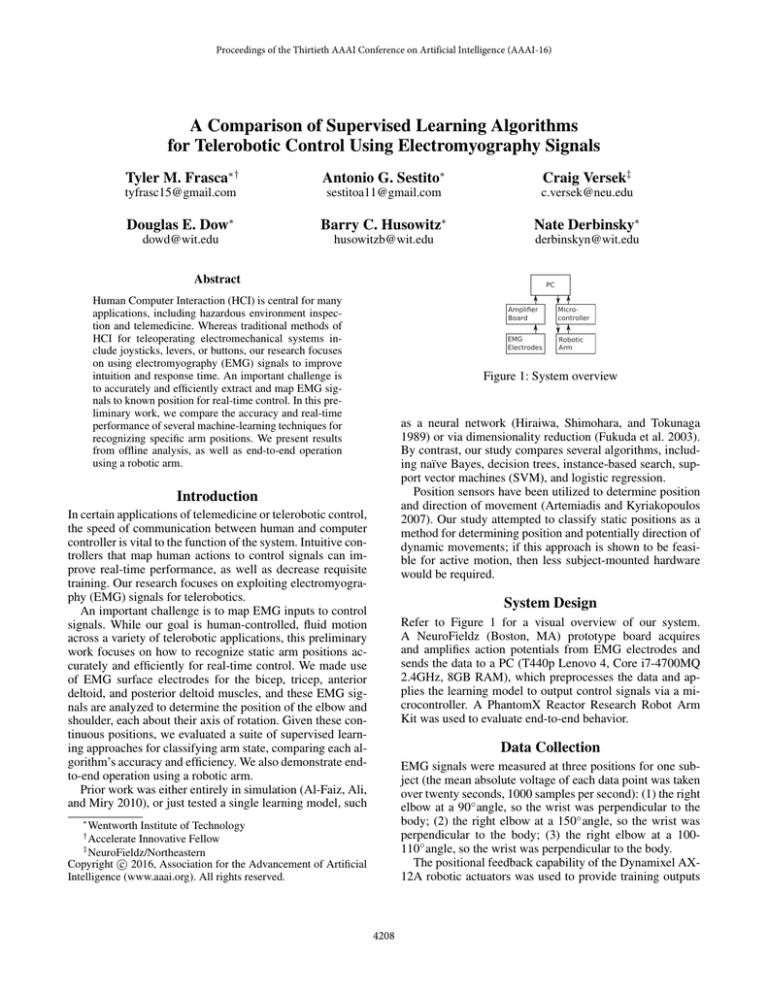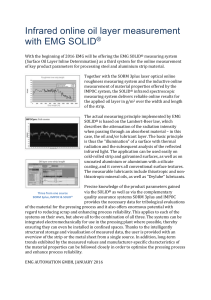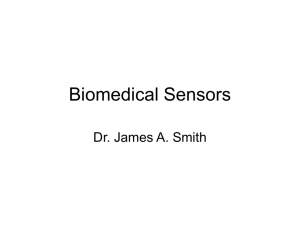
Proceedings of the Thirtieth AAAI Conference on Artificial Intelligence (AAAI-16)
A Comparison of Supervised Learning Algorithms
for Telerobotic Control Using Electromyography Signals
Tyler M. Frasca∗†
Antonio G. Sestito∗
Craig Versek‡
tyfrasc15@gmail.com
sestitoa11@gmail.com
c.versek@neu.edu
Douglas E. Dow∗
Barry C. Husowitz∗
Nate Derbinsky∗
dowd@wit.edu
husowitzb@wit.edu
derbinskyn@wit.edu
Abstract
PC
Human Computer Interaction (HCI) is central for many
applications, including hazardous environment inspection and telemedicine. Whereas traditional methods of
HCI for teleoperating electromechanical systems include joysticks, levers, or buttons, our research focuses
on using electromyography (EMG) signals to improve
intuition and response time. An important challenge is
to accurately and efficiently extract and map EMG signals to known position for real-time control. In this preliminary work, we compare the accuracy and real-time
performance of several machine-learning techniques for
recognizing specific arm positions. We present results
from offline analysis, as well as end-to-end operation
using a robotic arm.
Amplier
Board
Microcontroller
EMG
Electrodes
Robotic
Arm
Figure 1: System overview
as a neural network (Hiraiwa, Shimohara, and Tokunaga
1989) or via dimensionality reduction (Fukuda et al. 2003).
By contrast, our study compares several algorithms, including naı̈ve Bayes, decision trees, instance-based search, support vector machines (SVM), and logistic regression.
Position sensors have been utilized to determine position
and direction of movement (Artemiadis and Kyriakopoulos
2007). Our study attempted to classify static positions as a
method for determining position and potentially direction of
dynamic movements; if this approach is shown to be feasible for active motion, then less subject-mounted hardware
would be required.
Introduction
In certain applications of telemedicine or telerobotic control,
the speed of communication between human and computer
controller is vital to the function of the system. Intuitive controllers that map human actions to control signals can improve real-time performance, as well as decrease requisite
training. Our research focuses on exploiting electromyography (EMG) signals for telerobotics.
An important challenge is to map EMG inputs to control
signals. While our goal is human-controlled, fluid motion
across a variety of telerobotic applications, this preliminary
work focuses on how to recognize static arm positions accurately and efficiently for real-time control. We made use
of EMG surface electrodes for the bicep, tricep, anterior
deltoid, and posterior deltoid muscles, and these EMG signals are analyzed to determine the position of the elbow and
shoulder, each about their axis of rotation. Given these continuous positions, we evaluated a suite of supervised learning approaches for classifying arm state, comparing each algorithm’s accuracy and efficiency. We also demonstrate endto-end operation using a robotic arm.
Prior work was either entirely in simulation (Al-Faiz, Ali,
and Miry 2010), or just tested a single learning model, such
System Design
Refer to Figure 1 for a visual overview of our system.
A NeuroFieldz (Boston, MA) prototype board acquires
and amplifies action potentials from EMG electrodes and
sends the data to a PC (T440p Lenovo 4, Core i7-4700MQ
2.4GHz, 8GB RAM), which preprocesses the data and applies the learning model to output control signals via a microcontroller. A PhantomX Reactor Research Robot Arm
Kit was used to evaluate end-to-end behavior.
Data Collection
EMG signals were measured at three positions for one subject (the mean absolute voltage of each data point was taken
over twenty seconds, 1000 samples per second): (1) the right
elbow at a 90◦ angle, so the wrist was perpendicular to the
body; (2) the right elbow at a 150◦ angle, so the wrist was
perpendicular to the body; (3) the right elbow at a 100110◦ angle, so the wrist was perpendicular to the body.
The positional feedback capability of the Dynamixel AX12A robotic actuators was used to provide training outputs
∗
Wentworth Institute of Technology
Accelerate Innovative Fellow
‡
NeuroFieldz/Northeastern
c 2016, Association for the Advancement of Artificial
Copyright Intelligence (www.aaai.org). All rights reserved.
†
4208
Number of Samples
We found that all the algorithms correctly classified operator position with at least 89% accuracy. kNN (k = 4;
we evaluated k values 1–10) yielded the greatest accuracy
(> 97%) with virtually no training time. Random Forests
had similar accuracy, but required 120ms for training.
For real-time control it is critical that model prediction
takes no longer than 50 milliseconds. For this relatively
small dataset, all of the algorithms far surpassed this requirement, requiring less than 1 millisecond on average.
Bicep
14
Position 1
Position 2
Position 3
Position 1
Position 2
Position 3
12
10
8
6
4
2
0
1
2
3
4
5
6
7
8
9
Voltage (μ V)
Figure 2: Histogram of the Bicep mean absolute value for
the three positions
Accuracy (%)
Training (ms)
Testing (ms)
NB
90.0
0
0.02
SVM
95.7
20
0.15
LR
90.1
30
0.03
kNN
97.8
0
0.08
J48
95.1
20
0.02
Discussion
Based on the results of the algorithmic evaluation, kNN was
selected and a single operator was successfully able to control the robotic arm using static arm positions.1 This is important because static positions can be used alongside dynamic movements to help determine the direction of movement using only action potentials from the EMG recordings.
All of the algorithms were fast enough for real-time control, but kNN and Random Forests were qualitatively more
accurate. Unfortunately, the kNN algorithm becomes slower
with an increased training set size. We intend to explore
Boundary Forests (Mathy et al. 2015) as an online variant
that will maintain accuracy and efficiency over time. A pitfall of Random Forests is that they are classically trained offline, which limits their usefulness in this context – we plan
to evaluate more recent online variants (Saffari et al. 2009).
Following algorithmic improvements, we plan to evaluate
whether the system design generalizes to multiple subjects,
and additional static positions, with the eventual goal of continuous motion.
RF
97.3
120
0.02
Table 1: Evaluation results with naı̈ve Bayes (NB), support
vector machines (SVM), logistic regression (LR), k-nearest
neighbor (kNN), J48, and Random Forests (RF).
for the learning algorithms. While recording EMG signals,
the robotic arm was moved into an analogous position to the
right arm of the subject.
Preprocessing
The components of EMG signals that are useful for analysis
are lower than 400Hz, with the dominant section between
50 – 150Hz. The lower frequencies, below 20 Hz, were filtered out because (a) the signal voltage was superimposed
on a DC component and (b) motion artifacts. Thus, once
the data was collected, a band-pass filter with a lower frequency cutoff of 50Hz and an upper cutoff of 400Hz was
used to removed the DC components as well as some noise.
Additionally, the samples of EMG readings were rectified.
Finally, the mean absolute value of each of the four muscles
was calculated and used as an attribute for training/testing
sets. We hypothesized that given a relatively clean signal, a
supervised learning algorithm would learn to generalize over
remaining sources of noise.
References
Al-Faiz, M. Z.; Ali, A.; and Miry, A. H. 2010. A k-nearest
neighbor based algorithm for human arm movements recognition using EMG signals. In Energy, Power and Control
(EPC-IQ), 159–167.
Artemiadis, P. K., and Kyriakopoulos, K. J. 2007. EMGbased position and force control of a robot arm: Application to teleoperation and orthosis. In Advanced Intelligent
Mechatronics, 1–6.
Fukuda, O.; Tsuji, T.; Kaneko, M.; and Otsuka, A. 2003. A
human-assisting manipulator teleoperated by EMG signals
and arm motions. IEEE Transactions on Robotics and Automation 19(2):210–222.
Hiraiwa, A.; Shimohara, K.; and Tokunaga, Y. 1989. EMG
pattern analysis and classification by neural network. In Systems, Man and Cybernetics, 1113–1115.
Mathy, C.; Derbinsky, N.; Bento, J.; Rosenthal, J.; and
Yedidia, J. S. 2015. The boundary forest algorithm for
online supervised and unsupervised learning. In Proceedings of the 29th AAAI Conference on Artificial Intelligence,
2864–2870.
Saffari, A.; Leistner, C.; Santner, J.; Godec, M.; and Bischof,
H. 2009. On-line random forests. In Computer Vision Workshops (ICCV), 1393–1400.
Supervised Learning
Before comparing supervised learning algorithms, we plotted the mean voltage for each muscle corresponding to each
position. The bicep (Figure 2) and the anterior deltoid show
clear distinctions, leading us to hypothesize that the three
static positions could be distinguished.
Each supervised learning algorithm makes modeling assumptions, and thus the goal of this study was to evaluate a variety of approaches, comparing both accuracy and
training/testing time. For this application we evaluated naı̈ve
Bayes, support vector machine (radial basis function kernel),
logistic regression, k-nearest neighbors (kNN; L2 distance,
1
d weighting), J48 decision trees, and Random Forests. We
conducted 10-fold cross validation across 369 instances using Weka v3.6, with results summarized in Table 1.
1
4209
See: http://tmfrasca.info/emgrobotcontrol/






